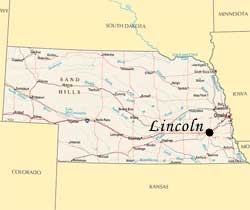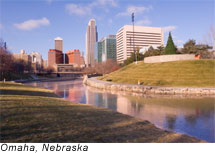 Nebraska was the site of the first land claim made under the Homestead Act of 1862. The act granted 160 acres of public land to any qualified person who lived on the land for five years and improved it. The act brought thousands of settlers to Nebraska.
Nebraska was the site of the first land claim made under the Homestead Act of 1862. The act granted 160 acres of public land to any qualified person who lived on the land for five years and improved it. The act brought thousands of settlers to Nebraska.
 Many of Nebraska's first farm settlers built their homes out of sod because there weren't many trees on the state's grassy land. Many of Nebraska's first farm settlers built their homes out of sod because there weren't many trees on the state's grassy land.
The first transcontinental railroad was built from Omaha, the state's largest city, to Sacramento, California. Existing railroads were also extended westward from Chicago to meet the new railroad. The building of the railroad brought prosperity to Nebraska's farms because it opened new markets for the crops grown there.
Nebraska is known for famous people who came from the state. Gerald Ford and Malcolm X were both born in Omaha. Ford was the 38th President of the United States. Malcolm X was a very influential militant Black Muslim leader during the 1950s and 1960s.
William Jennings Bryan, a leading politician who unsuccessfully ran for President of the United States three times, was a Nebraska congressman. Bryan advocated free coinage of silver and was supported by the state's farmers.
Nebraska's name comes from an Omaha or Otos Indian word "nebrathka," meaning "broad water" or "flat river." "Nebrathka" was the Indian name for the Platte River, the state's principal river. Nebraska is known as the "Cornhusker State." The nickname came from the nickname of the University of Nebraska's football team, which refers to the state's primary crop, and from cornhusking contests that were once held each fall in rural communities. Nebraska is also known as the "Tree Planters' State" because the annual Arbor Day tradition started there in 1872 when one million trees were planted on its barren plains. The abbreviation for Nebraska is NE.

 Nebraska, the only state with a one-house legislature, is a West North Central state bordered by South Dakota to the north, Iowa and Missouri to the east, Kansas to the south, and Wyoming and Colorado to the west. The Missouri River runs along the state's borders with Missouri and Iowa. Nebraska lies in the western part of the Great Plains. Nebraska, the only state with a one-house legislature, is a West North Central state bordered by South Dakota to the north, Iowa and Missouri to the east, Kansas to the south, and Wyoming and Colorado to the west. The Missouri River runs along the state's borders with Missouri and Iowa. Nebraska lies in the western part of the Great Plains.
Nebraska's varied landscape includes rolling plains, forested valleys, farms, and cities in the east; large wheat and corn fields in the state's central prairies; and grasslands, treeless plains, and intermittent streams in the west. The state was once considered to be part of the "Great American Desert," but the people who lived in the region were determined pioneers. They built irrigation systems and used scientific farming, making Nebraska's land profitable for farming and ranching.

 Those who considered Nebraska to be part of the "Great American Desert" would be very surprised by the state's transformation into one of the leading farming states. About 95 percent of the state's land is farmland -- that's a higher percentage than any other state. Nebraska's farmers grow corn, soybeans, wheat, hay, sorghum, oats, and sugar beets. Herds of cattle graze on long areas of pastureland. Those who considered Nebraska to be part of the "Great American Desert" would be very surprised by the state's transformation into one of the leading farming states. About 95 percent of the state's land is farmland -- that's a higher percentage than any other state. Nebraska's farmers grow corn, soybeans, wheat, hay, sorghum, oats, and sugar beets. Herds of cattle graze on long areas of pastureland.
Nebraska's cities profit greatly from food processing. It is also a leading center for insurance and finance in the Midwest. The headquarters for Mutual of Omaha is located in Nebraska.

Many tourists visit Nebraska each year. They can see the National Museum of Roller Skating in Lincoln, the state's capital, or visit Boys Town, the famous community for orphaned or abandoned boys near Omaha founded by Father Edward J. Flanagan, a Roman Catholic Priest, in 1917.
|

![]()
